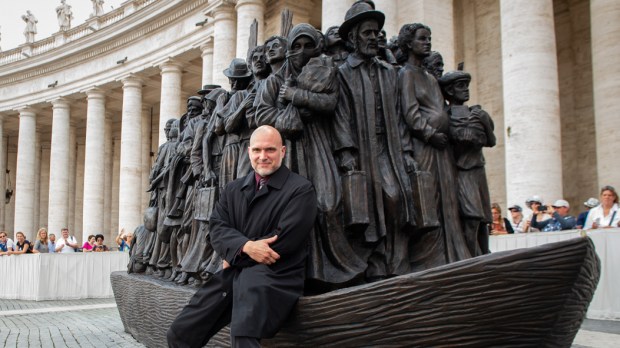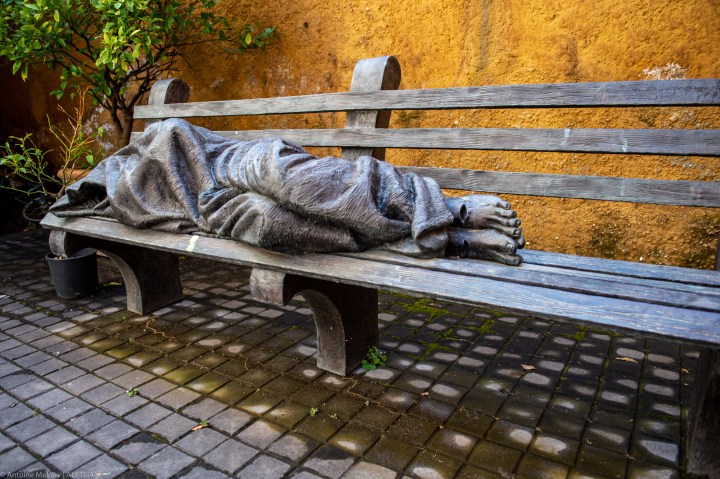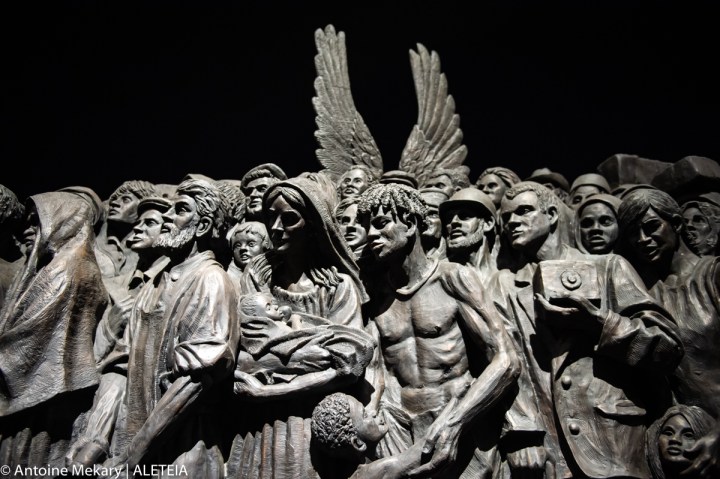Canadian sculptor Timothy Schmalz has been making Christian sculptures for more than 30 years. Drawing inspiration from Catholic and Christian themes as well as current social thought, he describes his creations as “visual prayers,” which force people to stop in their tracks and reflect on what they are seeing.
He currently has nine sculptures spread out between Rome and the Vatican, and a couple more should be added to the Eternal City in the near future. Aleteia interviewed the artist about his work.
What led you to sculpt works on Christian subjects and themes?
I have been sculpting Christianity for more than 30 years. When I was in my 20s I dropped out of art school because I found that I did not want to make art for arts sake, but I wanted to make art for God’s sake. I wanted my art to be an instrument for people to come closer to Christianity and spirituality. That is what I am still trying to do with a lot of my work, especially with the ones that are installed in Rome.
What was the first of your sculptures that was placed at the Vatican?
It was the “Homeless Jesus” in 2016. It was placed within the Vatican walls in the square in front of the Office of Papal Charities building. I first presented the original model for Pope Francis to bless it in 2013, and he said was beautiful representation of Jesus.
The sculpture has since been placed in cities all around the world: from Singapore, to Capernaum, to New York City. Since 2018 there is also one in the Trastevere area in Rome in front of the Sant’Egidio headquarters.
How did you come up with the idea for your now famous “Homeless Jesus”?
I was in Toronto when I saw a homeless person completely covered under a blanket. It was a haunting image and I said to myself, “That’s Jesus, I just saw Jesus in the center of Toronto.” I went back to my studio and I couldn’t get that thought out of my head. Through sculpture I wanted to communicate my experience: when people see a lump of cloth with a fragile human underneath they can also see something spiritual.
What about the “Angels Unawares” sculpture, which represents a boat of migrants and is installed in St Peter’s Square?
When the new Department of Migrants and Refugees opened within the Dicastery for Promoting Integral Human Development, I was requested to come up with a concept on this topic. For two years I was thinking of how to sculpt the passage of Hebrews 13:2, “Do not neglect to show hospitality to strangers, for thereby some have entertained angels unawares.” I was overjoyed about creating a piece that would spread this message globally, with it being in a central location like St. Peter’s Square in 2019.
The colonnade of the Square, designed by Giovan Lorenzo Bernini, is supposed to represent two outstretched arms welcoming everyone. My sculpture, representing people from all over the world, seems almost as if it sailing to St. Peter’s Basilica further reinforcing the idea that the Church is welcoming and loves all people. I also sculpted 140 figures on the piece because there’s 140 marble statues up on the colonnade. This gives me many opportunities to represent faces and emotions that can resonate with the people that come to St. Peter’s Square.
The idea was to show refugees from all historical periods with an angel in the center. You can’t see anything but its wings, symbolically suggesting that the wings are of all the migrants.
What models did you take inspiration from?
I wanted to represent on the sculpture real migrants and refugees. In fact I had some African refugees in Canada pose for me so I could sculpt their faces and bodies. I also knew that Cardinal Czerny’s, [Interim Prefect of the Dicastery for the Service of Integral Human Development] parents were refugees who came from the Czech Republic to Canada. I asked if he could send me some photos of them and I sculpted his parents at the back of the boat as a symbolic acknowledgment of Cardinal Czerny’s own history of migration.
I have German refugees escaping the Protest reformation, Protestants escaping from Catholic areas, Jews escaping Nazi Germany, Syrian Muslims fleeing conflict today, and so on. It’s not only a tapestry of migration but also a collage of humanity. The sculpture is a window into yourself. I placed the figures strategically so that there is not one angle that you can look at the piece and not see someone that resembles you. We have all, at one point or another in history, migrated from one place to the other.
Recently your sculpture “Let the oppressed go free” was brought to St. Peter’s Square during the Angelus on Sunday, February 6. What is the story behind this sculpture?
After the success of the “Angels Unawares” sculpture Cardinal Czerny asked if I could make a sculpture on the theme of human trafficking.
I started studying the horror of human trafficking. I thought about how omnipresent this evil is in the world and I came up with the concept of having the modern slaves, the trafficked people, being lifted out of this underground world into the light. The theme of the sculpture is one of hope but also information. The sculpture has around 100 different representations of the faces of human trafficking, which often are invisible. This sculptures brings visibility by crystallizing their emotions and their struggle.
This is also a monument to Saint Bakhita, who was a slave herself a century ago and who is spiritually fighting slavery today.
Where will this sculpture be placed?
The 6-foot model was blessed by Pope Francis and will be placed somewhere in Rome. The 20-foot versions are being installed in different places around the world, most notably in Washington, DC and Montreal, and one in Italy at a location that will be announced shortly. The idea is to create 10 pieces to be placed in 10 locations around the world to bring awareness of human trafficking. It is a very dramatic sculpture that hopefully will become a permanent part of the city’s fabric and will stop people in their tracks to make them aware of this issue.
How do you think sculpture helps you transmit Christian values?
Sculpture is one of the greatest forms of communication because it takes up real 3-dimensional space. It is more powerful than painting and other forms of visual artwork simply because it stands out.
Sculpture also has the perfect feature of being able to be placed outside. Oftentimes people today can feel intimidated to go into a church or might not want to go in because they have negative ideas about the Church. Sculpture allows you to bring the church out to the people.



